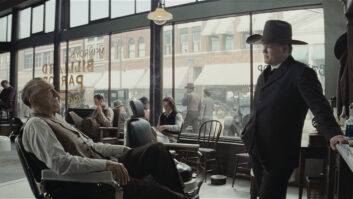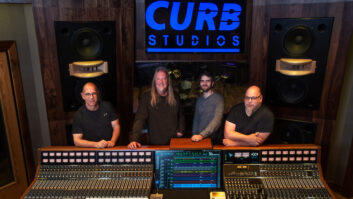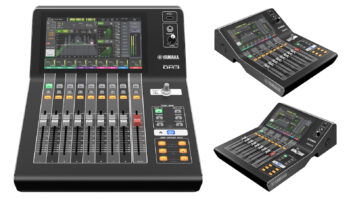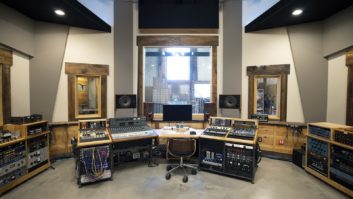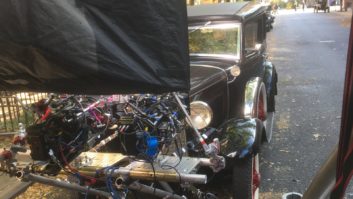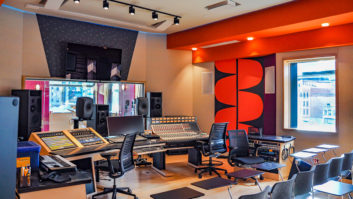It makes sense for engineers to reach for proven gear and techniques to address everyday mixing challenges. And with lower budgets forcing shorter production cycles and, ultimately, more no-nonsense mixing, it can be a challenge to find room for experimentation. But mixers who have the opportunity to work with experimentally inclined artists are pushed to find new ways to satisfy their clients’ sonic curiosity. The engineer/producers we talked to for this article will let loose creatively when mixing a record if given the latitude.
BEYOND THE BOUNDARIES
Indie-rock bands come from far and wide to work with producer/engineer Peter Katis in his Bridgeport, Conn., Tarquin Studio. Often, Katis co-produces, records and mixes, as he’s done for Interpol, The National, The Grates and Tokyo Police Club. Now more than ever, Katis enjoys the freedom bands give to indulge his creative instincts in the mixing process.
“Bands tend to come to me because they like the sound of records I’ve done and they want me to do ‘that’ to their record,” says Katis. “For example, I tend to go for a heavy, muscular drum sound, even in gentler music. A lot of times in the mixing stage, I can make a drum kit I haven’t recorded sound like one I did record.”
Katis will use parallel compression on drum tracks in his hybrid analog/digital mixing environment. “I’ll bring all the drum tracks in Pro Tools up on my analog board and use subtle analog EQ and compression and then print it all back into the computer,” Katis shares. “But I’ll also print a bunch of extra tracks of parallel compression — nailing a kick, snare or everything — with a compressor and then print it to its own track and blend it in with the uncompressed sounds. I’ll do that on every record, but vary the amount of crazy, aggressive drum sound when I’m doing the final balances.”
Katis notes that the most radical changes he’ll enact during the mixing stage lately will more likely be to add musical flourishes for texture rather than doing any extreme sound processing. “I’ll suggest we add a bunch of additional guitar and keyboard parts in a section, and the band will be surprised at the suggestion, but then we’ll do it and they’ll be into it,” says Katis. “It’s a tricky thing to mix to the point where you feel you’ve done everything you can do with the tracks, sonically, and you know it’s just about adding more, musically. And the musical additions tend to be subtle, but they add something that no amount of processing could.”
Katis recently co-produced, recorded and mixed the new album by Scottish indie-rock band Frightened Rabbit whose sound — though suitably gritty and rough-around-the-edges — feels lush and filled-out on the record. “A lot of the record is pretty stripped down, but on some songs there’s actually loads of low-key and ambient stuff going on,” Katis describes. “During mixing on the song ‘Backwards Walk,’ for example, we added lots of cool little musical harmonies — little guitar swells and feedbacks and keyboard lines that ripple in and out.”
Distortion tends to come in big on Katis records. “Usually, the more I can distort things the better,” he says. “I am not as much a fan of compression as I am the distortion that a cool compressor can bring. In addition to the parallel compression technique, where I blend certain overcompressed tracks, lately I’ll overdrive the entire drum bus and you’d never know that it’s distorted; it just sounds cooler. Drums love to be overdriven — you’ll get all sorts of tone out of them that otherwise you’re just not hearing.” Even in the most modest treatments, Katis adds, the drum bus will go through a Neumann EQ and an API 2500 compressor.
When working on vocals, Katis looks for opportunities to blend interesting textures in by effecting the double or background vocals. “I just got this new preamp from No Toasters and it has this setting where you can overdrive it insanely; we used it on The Grates’ album to record a lot of the doubles,” Katis says. “I’d completely overdrive the double and then tuck it underneath the regular vocal, and it sounded awesome. At the end of a couple songs, you hear it full-on and it doesn’t sound like a human voice — more like a Moog synthesizer.”
SOUNDS OFF THE BEATEN PATH
Working with the pop avant-garde, including Björk, Mum, Camille and Coco Rosie, crafting the experimental-classical movements of rising-star composer Nico Muhly and producing electronic music of his own, Icelandic producer/engineer/programmer Valgeir Sigurdsson engages in highly creative engineering. Two recent records — Camille’s Music Hole and Muhly’s Mothertongue — illustrate Sigurdsson’s imaginative style and technical prowess.
Sigurdsson was the ideal engineer for the avant-acapella style of French pop chanteuse Camille. “I’ve done a lot of experimenting with human voices, beat percussion and vocal layers — since Björk’s Medulla album — so Camille and her producer insisted I do all the recording and mixing on Music Hole. I was kind of like their sound advisor,” says Sigurdsson. “It was composed with limited sources — vocals, body percussion, beat-boxing, sonic textures and piano — and so it was a very creative recording role because they trusted me to make decisions on how we should create a lot of the sounds.”
While he recorded Camille in France, Sigurdsson mixed Music Hole back at his Greenhouse Studio in Reykjavik on his integrated SSL AWS 900 and Pro Tools HD3 system. “It was a complicated album and called for some creative solutions,” he says. “For example, some of the vocals are in French and some are in English, and we wanted to find a way to make them different sonically, too. According to Camille, the French always want to hear lyrics clearly. So I ran the French vocals on the song ‘Canards Sauvages’ through an SPL Vitalizer, which made those French vocals stand out in a different way; they’re brighter and jump forward in the mix. This became a blueprint for the vocals on the rest of the album.”
On both the Camille and Muhly records, Sigurdsson weaves countless elements together in a mix where nothing gets lost, where every part — from the most minimal to the lushest soundscapes — feels present and essential. “I think mainly, when there are many elements but everything seems very clear and present, it has a lot to do with my EQs,” he says. “I use the SSL EQs on the AWS 900 all the time. My rack of Neves [1073s and 1084s] and my API 550B are also really important.” He also uses reverbs to create space in the mix. “I find it very useful, especially with albums that are tracked layer by layer, to ‘glue’ the elements together with different reverbs and sometimes delays. My reverb of choice is usually the Eventide Reverb plug-in; I typically have a few sends set up with various reverb types and lengths.”
Mothertongue, particularly for the scale of its composition, posed unique mixing challenges. Muhly composed Mothertongue in three 15 to 20-minute sections, which ultimately broke down on the record into three songs per section, plus a bonus track. The first section, called “Mothertongue Parts I-III,” changed the most in the mixing process, says Sigurdsson. “The final section of Mothertongue was never big enough when we were recording it; during mixing, I added another layer of bass and these monsters Nico asked me to create, which I made by processing the sound of crunching cereal. In another part of Mothertongue. we created an interesting texture with the sound of whale meat sloshing around in a bowl.”
Prior to buying the AWS 900, Sigurdsson says much of his mixing was done in-the-box. “I prefer to mix through an analog desk, but it was frustrating to be in two different places when you’re in the middle of the mix,” he says. “Going from Pro Tools to an analog console was like playing a piano and then having to stand up and strap on your guitar — pretty annoying when you had a flow going.” Sigurdsson calls his new setup “hands-on” and “intuitive,” all-important qualities for facilitating endless creativity.
ENERGY OVERLOAD
Producer/engineer Alan Weatherhead has mixed records for Sparklehorse, The Comas, Camper Van Beethoven and Cracker, among numerous other indie bands that appreciate his naturally experimental style. The bands that hire Weatherhead to mix their records usually share this aesthetic: “The records I’ll mix have usually been created with an experimental energy, and so they want to continue in that direction,” he notes. “So my job is to take it a little further in some cases, and in others figure out how I can subtract from what’s there to make it stronger.”
Weatherhead works in Sound of Music Studios in Richmond, Va., and his mixing arsenal is distinguished by his affinity for effects pedals, Amek 9098 channel strips and Distressors. He mixed the new record by A Camp, the New York City-based indie-rock band led by Nina Persson of The Cardigans, at Firehouse 12 Studios in New Haven, Conn. “The band gave me license to do whatever I wanted in mixing, basically,” says Weatherhead. “You never know what the outcome of some sonic experiment will be, and it’s part of my approach to try anything. First I get things in place, and then ask, ‘Texturally, what would make things more interesting?’”
Weatherhead mixed the A Camp record in Pro Tools, running most everything through Firehouse 12’s API Legacy console, and using both analog pedals and software effects to add dimension to their recorded sounds. “On one song, we ran this single note acoustic guitar part through Eventide’s H949 plug-in, basically bringing the guitar up an octave and adding reverb to it,” he recalls. “On its own, it sounds completely glitchy, almost not musical. But in the mix, having some of that underneath the guitar made it sound like a 12-string.”
On vocals, Weatherhead used parallel compression and experimented with tape delay. “We’d record the tape delay and then line it up so it was actually in time with the vocal to give it a fatter, thicker sound.” Backing vocals were run through a variety of filters. “I have a pedal made by Frostwave called the Resonator, and it’s basically a clone of the filter section of an MS20 synth. And like the tape delays, a lot of times the vocal would be running through the Resonator and we’d be manipulating it as we were recording it. We used the Sherman Filterbank on a lot of stuff, particularly on drums.” In general, Weatherhead adds, “What we’re doing with all these filters is never the whole sound, but another layer, something else snuck in there for texture.”
Mixing a record for singer/songwriter Nadine Khouri recently, Weatherhead used distortion as a creative solution to a less-than-ideal recording. “There’s one song on her record that had a really heavy ending, but since they’d recorded basics for it on the same day they cut a few mellower songs and didn’t change the drum sound for the heavier one, it didn’t sound quite right,” he explains. “So we put the snare drum through a distortion pedal and gated it, just made it sound super-crazy. Sometimes it’s better to make a sound that’s not working so well into something totally different rather than trying to be so literal about it.”
BRINGING IN THE “LIVE” FEEL
After recording and mixing one of the coolest-sounding records of recent years — Gnarls Barkley’s sleeper hit, St. Elsewhere — Atlanta-based producer/engineer Ben H. Allen popped up on the radar of bands everywhere. Allen describes the album as “futuristic and vintage,” a sound that, from an engineering perspective, tied in naturally with his personal aesthetic. “I grew up listening to Motown records,” Allen shares, “which to this day are my reference point for how music should sound.”
No matter what kind of music he’s engineering, Allen finds himself returning to techniques he can trace directly back to those records. “I’m doing a lot of things in mono these days, less stereo in terms of where things are sitting in the mix, especially with effects,” he points out. “That spring and plate reverb used in those old Motown records was all mono, and it gives off this eerie quality but it’s not super-wide and lush-sounding. So, if anything, my mono effects have become a bit of a trademark for me lately.”
While Allen’s discography is decidedly urban — having engineered late-’90s New York City hip-hop and later helping to cultivate the Dirty South crunk movement — his work has attracted more rock bands lately, and most recently the über-experimental Brooklyn, N.Y., art-rock band Animal Collective. “They hired me to record and mix because they wanted really aggressive low end on their new album,” he says. “My background being in urban music, managing low end is one of the things I do really well.”
Just before hitting Chase Park Transduction Studios to mix the Animal Collective record, Allen describes the recording and premixing process: “To get the low end they wanted, we set up four different re-amping stations in the studio — using a Fender spring reverb, an Ampeg Portaflex bass amp, a little Gibson guitar amp and the huge QSC P.A. system they use for their live shows. They’d record things straight out of their samplers through the Neve 80 Series desk into Pro Tools and then we’d re-amp the kick drum, or the snare drum, or 20 snare drums, or bass synth parts through one of those stations, pick the sound we liked best and record that back into the computer.”
Putting up room mics and re-amping these low-end elements gives the band the “live” sound, as Allen explains. “We’re using that setup to create ambience that didn’t exist in the samples themselves, which makes them sound like a band playing in a room.”
Premixing in-the-box throughout the recording process allows Allen to begin dabbling with effects early. “As each part gets recorded, and often triple- or quadruple-tracked, I take all those mics and run them through an aux input in Pro Tools and effect it at that stage and get a balance,” he explains. “So once I open up the Pro Tools sessions, the rough mixes are all balanced, and in mixing it becomes a question of what will be up front and what will go behind? Also, we’ve left it open enough so that we can make decisions on how much room — or dirt — we want on the sound, or how closed and tight we want it to feel.”
Going into the mix, Allen describes, “The whole vibe is to have this really tight and punchy low end, like a New York hip-hop record, and then this really washy Beach Boys-style vocal approach. We went and bought a bunch of spring reverbs and cheap reverbs on eBay that we’re going to use for vocals, a lot of which are triple- or quadruple-tracked.”
Allen will use his 32 channels of outputs to submix on the Sony MXP3036 console at Chase Park, and plans to use the studio’s plate reverbs, as well as outboard and plug-in effects, including a recent discovery: Audio Ease’s Speakerphone. “They’ve booked two weeks to mix 12 songs and they want to experiment as much as possible.”
[Eds. Note: Read an expanded version of this feature at www.mixonline.com.]
Janice Brown is a freelance writer based in New York City.

